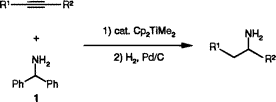I did a search and did not see this posted...
PDF:
http://mishmashblue.tripod.com/orglett.pdf
DOI:
10.1021/ol006011e
An Ammonia Equivalent for the Dimethyltitanocene-Catalyzed Intermolecular Hydroamination of Alkynes
Commercially available
alpha-aminodiphenylmethane
1 (benzhydrylamine) serves as a convenient ammonia equivalent in the dimethyltitanocene-catalyzed intermolecular hydroamination of alkynes. The primary formed imines can be hydrogenated and cleaved directly to the corresponding primary amines by catalytic hydrogenation using Pd/C as catalyst.
First we found that hydroamination reactions between
alpha-aminodiphenylmethane
1 (benzhydrylamine) and various alkynes
2 yielding the corresponding imines
3 can be realized efficiently in the presence of 3 mol % of Cp
2TiMe
2 at 110-120° C in the absence of a solvent. The reactions are generally very clean but, however, relatively slow. For bisaryl alkynes and alkyl aryl alkynes, the reactions proceed to completion within 72 h. In contrast, reactions employing bisalkyl alkynes do not reach 100% conversion after 72 h. As shown previously, for unsymmetrically substituted alkynes such as alkyl aryl alkynes and terminal alkynes the hydroamination reactions occur with high regioselectivity, forming the anti-Markovnikov products exclusively.
Further investigations showed that the crude imines
3 can be directly reduced to the desired primary amines
4 by catalytic hydrogenation under 1 atm of H2 at 25° C using 1.5-5 mol % of Pd/C as catalyst.
The unsymmetrically substituted alkyl phenyl alkynes 1-phenyl-1-propyne
2b was regioselectively converted into the biologically interesting phenylethylamine 2-amino-1-phenylpropane (amphetamine)
4b in 79% yield.
Reaction conditions:
1.0 equiv of amine, 1.2 equiv of alkyne, 3.0 mol % of Cp
2TiMe
2, 110° C, 72 h; (2) 1 atm of H2, 1.5 mol % of Pd/C, THF, 25° C, 72 h. Reaction times have not been minimized.
5 mol % of Pd/C was used for the reduction step.
3.0 equiv of alkyne was used for the hydroamination step.
20 h reaction time for the hydroamination step.